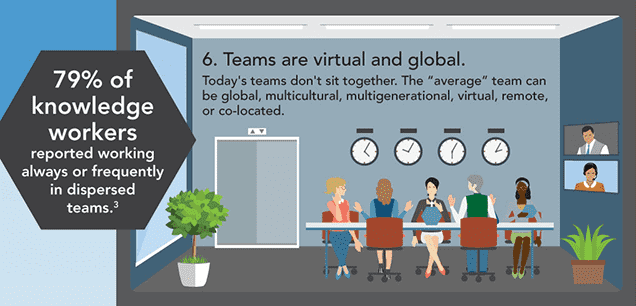
So far in this blog series, I’ve described five of the eight market forces impacting organizations. Number six is where the rubber meets the road: The teams who are doing all the work. Not only are they tasked with executing to your strategy, they are also expected to gracefully pivot to ever-changing demands and deadlines. Yet their jobs are becoming more complex: They are increasingly working with different sets of tools, processes and people across time zones, cultures and organizational boundaries.
For these reasons, it is imperative that organizations help their virtual and global teams work effectively together.
- Outcomes are different
- Capabilities must be strategic
- Work methodologies are proliferating
- Unstructured work is exploding
- Plans are even more critical
- TEAMS ARE VIRTUAL AND GLOBAL
- Technology is everywhere
- Resources are multiplying
I discussed this phenomenon last year at our customer conference (see video below). Based on our conversations, I would say that every organization represented at our event is facing a more virtual and global workforce. Planview is for sure.
Teams Are Increasingly Virtual and Global
Consider these findings:
- A survey of 1,372 business professionals in 80 countries found that 85 percent work on virtual teams. Nearly half of these teams include members from other nations, and 41 percent never meet in person. (R3W CultureWizard)
- A survey of 1,700 knowledge workers found that 79 percent reported working always or frequently in dispersed teams. (Ferrazzi Greenlight research cited in Harvard Business Review)
- A survey of 200 North American business professionals found that 70 percent work with internal and external team members, while nearly 40 percent work on teams across functions and departments. In addition, almost one-third work with geographically distributed team members (Projectplace).
Effectiveness of Virtual Teams Varies
How effective are these teams? Clearly, it’s more difficult to work as a virtual team. Yet we see examples every day of teams doing incredible things. Many studies have concluded that employees working on virtual teams are more productive. One study of 80 software development teams from 28 labs worldwide showed that virtual teams can outperform those situated together, but only if managed correctly.
There is also evidence of dysfunction among virtual teams, especially as they become more prevalent. Nearly 60 percent of those surveyed in the R3W CultureWizard survey said that team leaders are not prepared to lead multicultural teams. Ferrazzi Greenlight’s research concludes that people believe face-to-face communication is more effective than virtual, and that collaboration technology confuses and overwhelms employees.
In fact, the ProjectPlace survey revealed that respondents waste nine weeks per year in productivity time due to the complexities of collaborating across different boundaries and toolsets. The survey respondents said they use about four tools on average to manage different projects. Despite the plethora of apps and other technologies out there, their top three tools for collaboration are email (73 percent), spreadsheets (62 percent) and the phone (53 percent).
About 40 percent of respondents said they have tried other online collaboration tools, but these are only “partial” solutions such as cloud-based storage (e.g., Google Drive), online cloud tools, and shared spaces such as SharePoint. Lack of standardization is another issue: More than one-third stated that no one on their team is using the exact same set of tools.
Depending on outdated, disparate tools for collaboration among virtual teams is a great hindrance to organizations. With all the other forces straining teams, including the increase in unstructured work and the propagation of work methodologies, it’s no wonder they are having issues.
Work and Resource Management for Virtual and Global Teams
The literature advising virtual teams on how to best work together is vast. In the Harvard Business Review article, Ferrazzi Greenlight CEO Keith Ferrazzi says it boils down to the right team, the right leadership, the right touch points, and the right technology.
Does Planview have a product to help virtual and global teams improve collaboration? Of course we do (it’s Projectplace)! But the challenge is broader than that. We understand that tech is not a panacea, but it is a necessity in today’s complex, always-changing, increasingly digital environments. Applied correctly, technology can help you turn the market forces working against you into an asset.
This is why we have oriented our approach and our product line to Work and Resource Management (WRM). Our solutions are built to integrate strategy and execution across all an organization’s work and resources, while ensuring that it has the capacity and financial resources required to accomplish its objectives.
According to Ventana Research: “Having a dedicated software approach to manage the work life cycle and use of resources is becoming an imperative for organizations; it will reduce the chaos of work distractions and ensure work can be conducted and tracked toward objectives…Work and resource management should ensure that the portfolio of all resources can be utilized to support the business and IT priorities of the organization, including where mobility and collaboration are required to support how work is conducted.”
Our product line spans strategic planning, portfolio and resource management, work collaboration, and enterprise architecture. Using these products, our customers improve resource utilization, accelerate time to market, and yes, increase productivity of project teams.
Stay tuned for force #7: Technology is everywhere. In the meantime, for more information on all eight forces working against your business, visit https://www.planview.com/work-resource-management/.
I’d like to hear from you. How does your organization typically plan and execute on products, services, and applications? Share by leaving a comment below.







